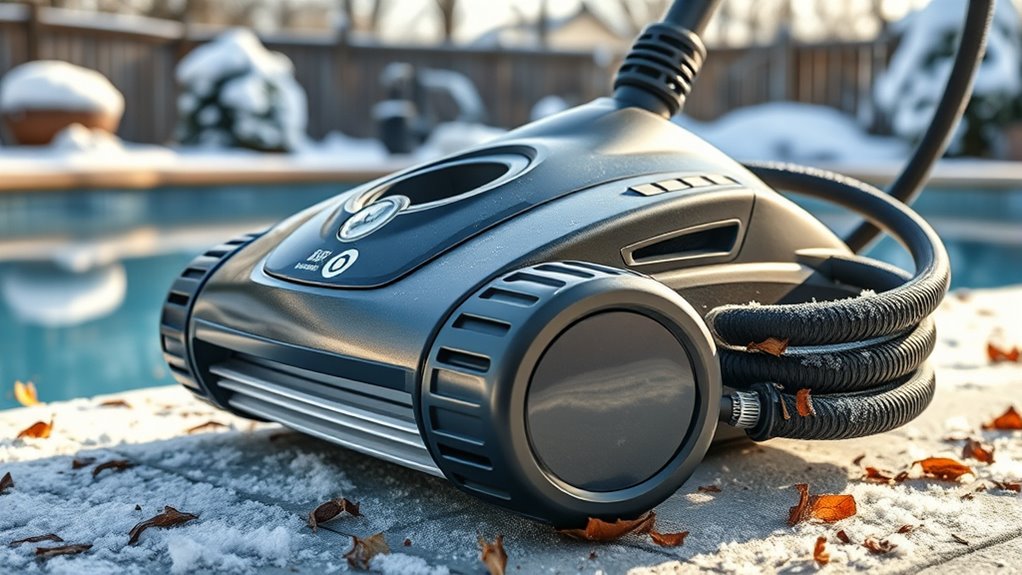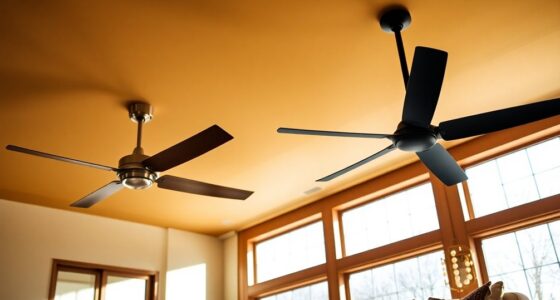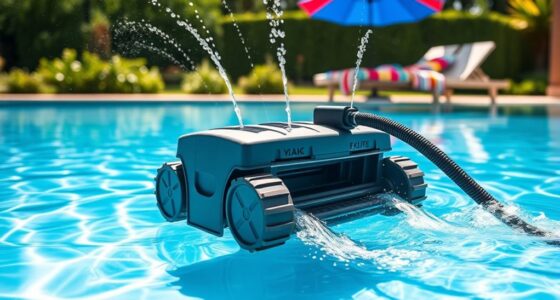To properly care for your pressure pool cleaner during the off-season, disconnect it from the pool, disassemble hoses and removable parts, and clean them with mild solutions like vinegar or pool cleaner. Inspect all components, replacing worn or damaged parts, and store everything in a dry, sheltered area away from harsh weather. Protect the power supply and hoses, and run the cleaner periodically in water to check for issues. Keep going to learn more tips to keep your cleaner in top shape.
Key Takeaways
- Disassemble hoses, brushes, and removable parts, then clean with mild solutions and rinse thoroughly before storage.
- Store equipment in a dry, sheltered environment, elevating and covering it to prevent weather damage.
- Check hoses and power supply for cracks or wear, and replace damaged parts to ensure longevity.
- Drain all water from components and hoses to prevent freezing and corrosion during the off-season.
- Periodically run the cleaner in water to monitor for issues and maintain readiness for the next season.
Disconnecting and Cleaning the Equipment
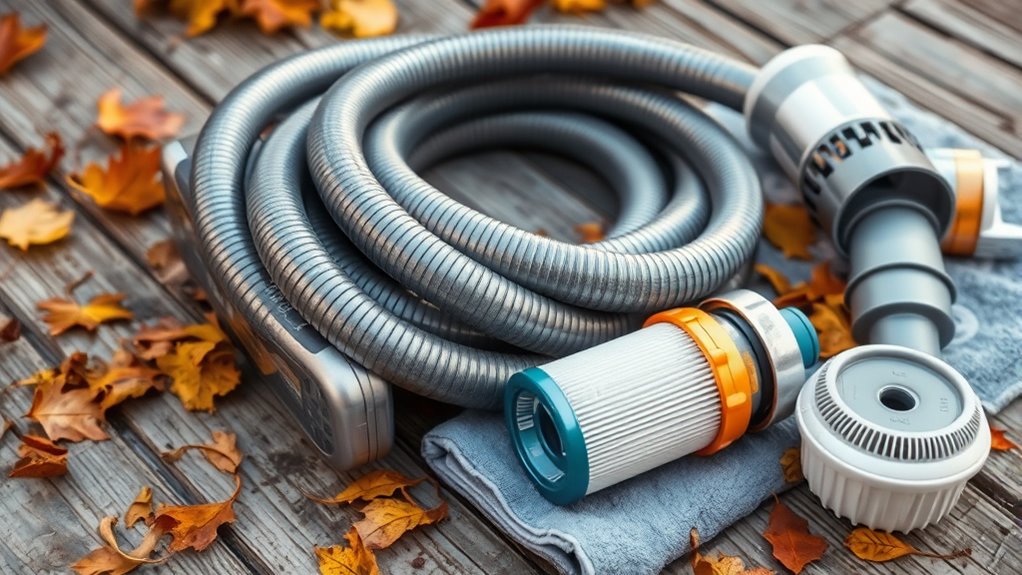
When it’s time to store your pressure pool cleaner for the off-season, start by disconnecting it from the pool’s filtration system. Carefully perform equipment disassembly, removing hoses, brushes, and other removable parts. This step prevents damage and makes cleaning easier. Next, give your cleaner a thorough chemical cleaning to eliminate any algae, dirt, or residue that could cause mold or deterioration during storage. Use a mild pool cleaner or vinegar solution to scrub parts, then rinse everything with fresh water. Dry all components completely to prevent corrosion. Proper disassembly and chemical cleaning not only extend your cleaner’s lifespan but also ensure it’s ready for use when the season resumes. Additionally, considering proper maintenance techniques during cleaning and storage can help preserve the equipment’s visual clarity and performance. Regular inspection and preventive care can further protect your equipment from potential damage. Taking these steps keeps your equipment in top condition and ready for next season.
Inspecting for Wear and Damage
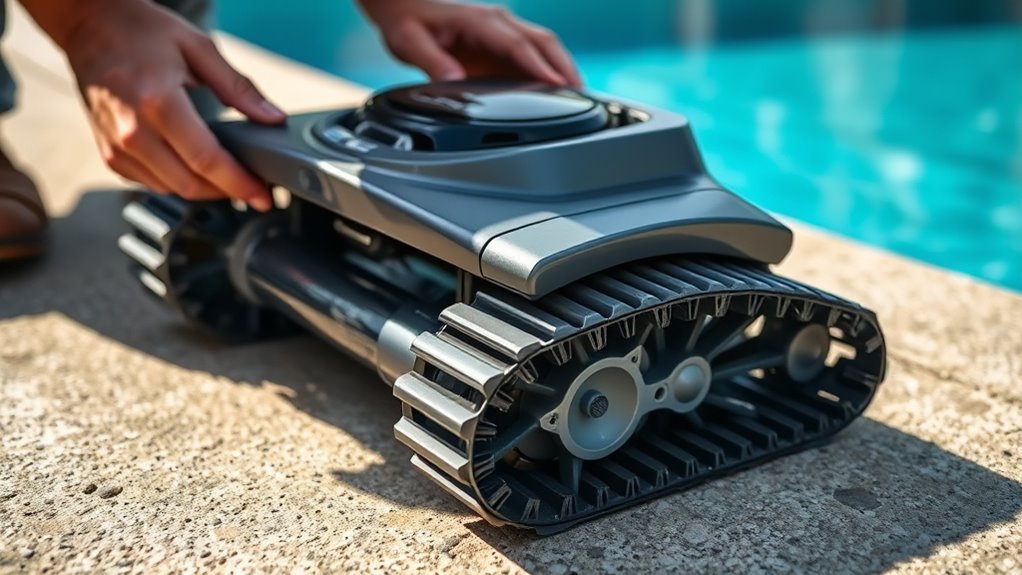
Before storing your pressure pool cleaner for the off-season, it’s essential to thoroughly inspect it for wear and damage. Begin with a brush inspection, checking for cracks, worn bristles, or missing parts that could affect cleaning performance. Next, examine the seals for integrity; look for cracks, tears, or signs of deterioration that might cause leaks or reduce suction. Ensure all hoses are free of holes or abrasions, and verify that connections are secure. Pay close attention to any visible wear on wheels, tracks, or brushes, replacing parts if necessary. Addressing these issues now prevents further damage during storage and ensures your cleaner will work efficiently when you restart it. Taking these steps helps prolong the lifespan of your equipment and reinforces the importance of preventative maintenance to keep your pressure pool cleaner in top condition. Regularly inspecting the wear and tear on components can help identify potential problems early and avoid costly repairs later, especially considering that routine check-ups can significantly extend equipment longevity. Incorporating these inspections into your seasonal maintenance routine can further safeguard your investment and ensure optimal performance.
Proper Storage Techniques
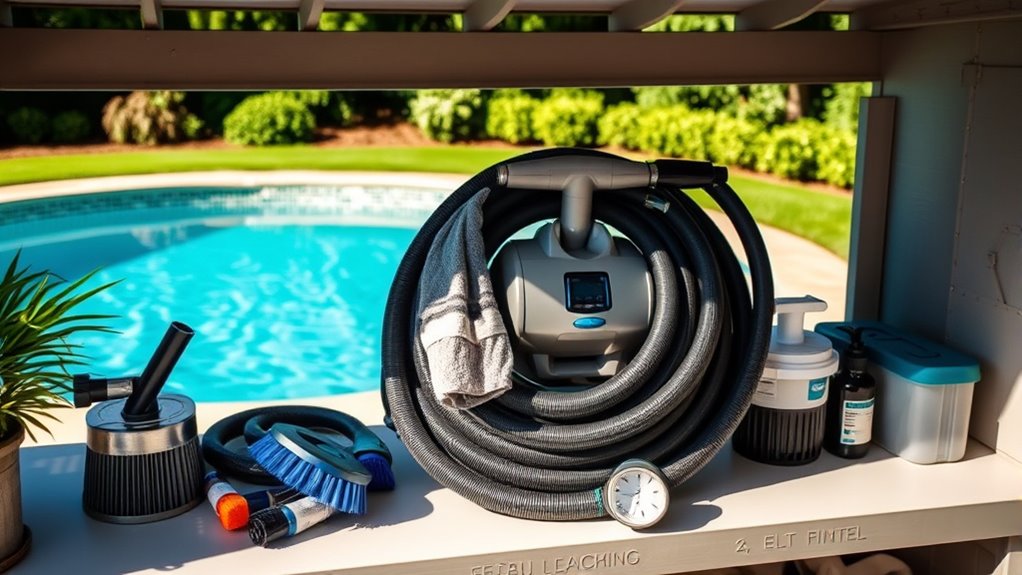
Before storing your pressure pool cleaner, make sure to drain and clean it thoroughly to prevent damage. Store it in a dry, sheltered location away from harsh elements to prolong its lifespan. Proper storage helps guarantee your cleaner stays in top shape for next season. Using proper storage techniques can also help maintain the equipment’s condition during off-season storage. Additionally, ensuring the equipment’s protective covering is intact can shield it from dust and moisture. Planning your storage environment carefully can further enhance the longevity of your pressure pool cleaner.
Drain and Clean Thoroughly
Are you guaranteeing your pressure pool cleaner is properly drained and cleaned before storing it for the off-season? Following the right storage tips begins with thorough draining to prevent water from freezing inside the hoses and components. After draining, clean your cleaner according to the cleaning procedures recommended by the manufacturer—removing debris, rinsing off dirt, and wiping down surfaces. Pay special attention to filters and brushes, ensuring no residue remains that could cause mold or corrosion. Properly draining and cleaning not only prolongs your cleaner’s lifespan but also makes spring startup smoother. Additionally, using the right keto-friendly oils can help maintain the moving parts and prevent rusting during storage. Incorporating proper storage techniques can prevent damage caused by environmental exposure and temperature fluctuations. Proper storage includes protecting your cleaner from extreme weather conditions that could accelerate deterioration. Skipping these steps can lead to damage or buildup that’s harder to remove later. Take your time during this process to ensure your pressure pool cleaner stays in top shape for next season. Proper maintenance is essential for optimal pressure pool cleaner performance and longevity.
Store in Dry Location
Once your pressure pool cleaner is thoroughly drained and cleaned, storing it in a dry, protected location helps prevent damage. Follow proper storage tips by choosing a cool, indoor space away from humidity and extreme temperatures. Climate considerations are important; in humid environments, consider using silica gel packs or a dehumidifier to keep moisture at bay. Avoid leaving the cleaner in direct sunlight or areas prone to temperature fluctuations, as these can cause material deterioration. Ensure the hose and other parts are coiled neatly and stored off the ground to prevent warping or damage. Proper storage not only extends the lifespan of your pressure cleaner but also ensures it’s ready for use when the swimming season resumes. Additionally, understanding proper storage techniques is crucial for maintaining equipment longevity, especially considering the impact of climate on stored outdoor gear. Being aware of the effects of temperature fluctuations can help you select the best storage environment and prevent unexpected damage. Recognizing humidity’s role in material degradation can further aid in choosing optimal storage conditions.
Protect From Elements
To effectively protect your pressure pool cleaner from the elements, you need to contemplate the storage environment carefully. Weather protection is essential to prevent damage from rain, snow, or UV rays that can degrade parts over time. Use cover solutions like waterproof tarps or specially designed covers to shield your cleaner when not in use. Ensure the cover fits snugly to keep out moisture and debris. Elevate the cleaner off the ground to avoid contact with standing water or dirt. If possible, store it in a shed, garage, or sheltered area that minimizes exposure to harsh weather. Proper weather protection not only extends your pressure pool cleaner’s lifespan but also keeps it ready for quick setup when swimming season begins again.
Checking and Replacing Worn Parts
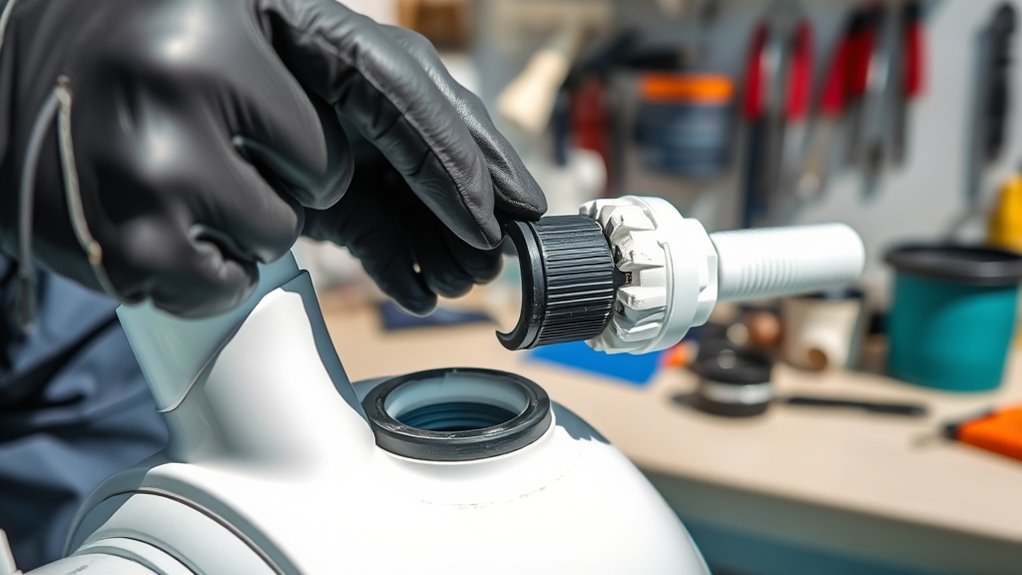
Before storing your pressure pool cleaner, you should check for signs of wear and tear. If you find any damaged components, replace them to keep your device in good shape. Properly inspecting and maintaining parts now will save you time and trouble when you need it next season. Regularly reviewing your equipment’s performance metrics ensures optimal operation and prolongs its lifespan. Additionally, inspecting the wear and tear on moving parts can prevent unexpected failures during use. Incorporating knowledge about essential oils for equipment maintenance can sometimes provide antimicrobial or soothing effects that help preserve rubber seals and other sensitive components. Understanding Kia Tuning principles can also help identify early signs of component degradation, ensuring your equipment remains in top condition. Being aware of sound healing science concepts may also offer insights into reducing vibrations that contribute to component fatigue over time.
Inspect for Wear and Tear
Regularly inspecting your pressure pool cleaner for wear and tear is essential to keep it functioning efficiently during the off-season. During a wear inspection, look for signs of deterioration such as cracks, fraying, or brittleness in hoses, brushes, and seals. Conduct a tear assessment by checking for any tears, holes, or weakened spots that could compromise performance. Pay close attention to moving parts like wheels, gears, and swivels, and ensure they move smoothly without resistance. If you notice any worn or damaged components, note them for replacement. Addressing these issues early helps prevent further damage and guarantees your cleaner stays in good condition until the next season. Regular checks save time and money by avoiding unexpected breakdowns. Additionally, understanding the importance of proper maintenance can extend the lifespan of your equipment and ensure optimal operation. Implementing a routine inspection schedule can help detect issues early, thereby avoiding costly repairs later.
Replace Damaged Components
When you notice signs of wear or damage during your inspections, replacing the affected components promptly keeps your pressure pool cleaner running smoothly. Conduct a thorough damage assessment to identify any cracked, worn, or broken parts, such as brushes, hoses, or nozzles. Component replacement is essential to prevent minor issues from escalating into major repairs or system failure. Use manufacturer-approved parts to guarantee compatibility and durability. Regularly check the condition of seals and gaskets, replacing them if they show signs of deterioration. By staying proactive and replacing damaged components early, you extend your cleaner’s lifespan and maintain peak cleaning performance. Proper damage assessment and timely component replacement are key steps in off-season care that save you time and money in the long run.
Store Properly for Off-Season
To guarantee your pressure pool cleaner stays in top condition during the off-season, it’s important to store it properly, especially after checking and replacing worn parts. During winter storage, ensure the cleaner is thoroughly cleaned and dried to prevent mold and corrosion. Store it in a cool, dry place away from direct sunlight and extreme temperatures. This off-season maintenance helps preserve seals, hoses, and other components. Before storing, disconnect and drain all water from the unit to avoid freezing damage. Keep the parts organized so you can easily inspect or replace them next season. Proper storage not only extends the lifespan of your pressure pool cleaner but also ensures it’s ready for quick setup when spring arrives.
Protecting the Power Supply and Hoses

Protecting the power supply and hoses during the off-season is crucial to guarantee your pressure pool cleaner remains in good working condition. Proper power supply protection prevents electrical damage, while hose safeguarding ensures flexibility and prevents cracks. To keep everything in top shape:
- Store the power supply in a dry, sheltered area, away from moisture and extreme temperatures.
- Check hoses for any cracks or wear, and coil them loosely to avoid kinks or damage.
- Cover or elevate the hoses to prevent dirt and debris buildup, preserving their integrity.
Regular Maintenance Tips During Off-Season

Regular maintenance during the off-season helps guarantee your pressure pool cleaner stays in peak condition. Start by checking the pool water chemistry before storing the cleaner. Properly balancing pH, alkalinity, and sanitizer levels prevents buildup and corrosion, ensuring your equipment remains in good shape. Perform seasonal maintenance by thoroughly cleaning filters and removing debris from hoses and brushes. Inspect for any signs of wear or damage, replacing parts if needed. Store the cleaner in a dry, protected area to prevent rust and deterioration. Regularly running the cleaner briefly in water during the off-season can help identify issues early. These steps keep your pressure pool cleaner ready for the next season, extending its lifespan and ensuring ideal performance when you need it most.
Preparing the Cleaner for the Next Season
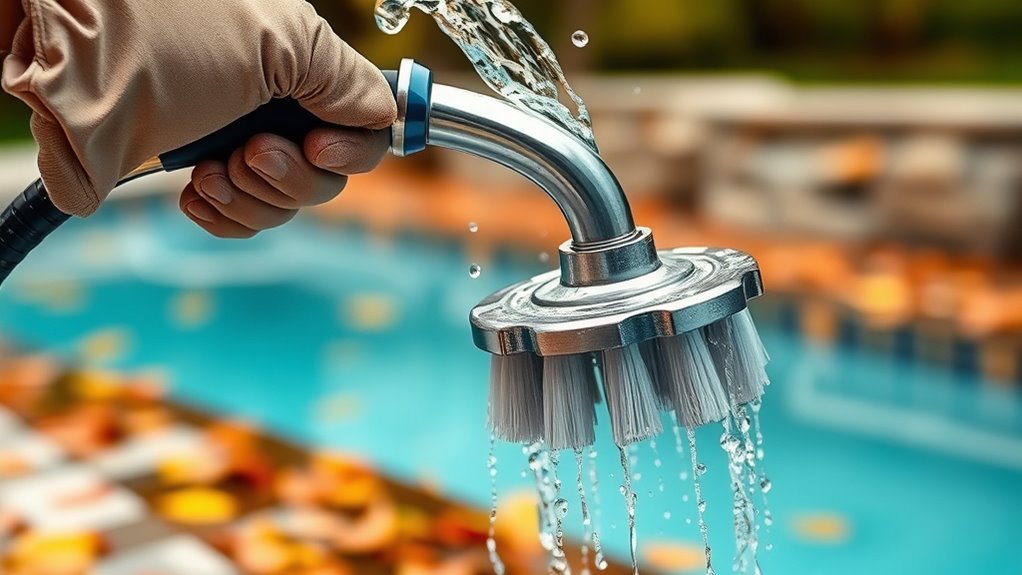
As the off-season comes to an end, it’s essential to prepare your pressure pool cleaner for the upcoming season. Start by cleaning and inspecting the unit thoroughly, ensuring there’s no debris or damage. Next, check your pool chemistry to confirm that chemicals are balanced, preventing corrosion or mold growth on the cleaner. Finally, follow safety precautions during storage: store the cleaner in a dry, cool place away from direct sunlight, and disconnect power sources. Regular maintenance now will extend the life of your pressure pool cleaner and ensure it’s ready to perform when you reopen your pool. Proper preparation helps avoid costly repairs and keeps your equipment in top shape for the next swimming season.
Frequently Asked Questions
How Often Should I Perform Maintenance During the Off-Season?
You should perform maintenance on your pressure pool cleaner at least once a month during the off-season. This includes checking for debris, cleaning filters, and inspecting hoses. Maintain proper cleaning frequency and follow storage tips to prevent damage. Store your cleaner in a cool, dry place, and make sure it’s completely dry before putting it away. Regular upkeep keeps your pressure pool cleaner ready for use when the season starts again.
Can I Leave the Cleaner Submerged in the Pool During Winter?
Did you know that improper winter storage can damage your pressure pool cleaner? Leaving it submerged in the pool during winter isn’t recommended, as freezing water can cause internal damage. For submerged protection, it’s best to remove the cleaner, clean it thoroughly, and store it in a dry, protected space. This prevents freezing and corrosion, ensuring your cleaner stays in great condition for next season.
What Environmental Factors Can Damage My Pressure Pool Cleaner?
Environmental factors can considerably damage your pressure pool cleaner. You should watch out for chemical corrosion caused by pool chemicals, which can weaken the device’s components. Biological growth, like algae or mold, can also build up if the cleaner isn’t properly stored or cleaned. These issues lead to deterioration and reduced efficiency. To protect your cleaner, store it in a dry, protected area and rinse off chemicals and biological matter after each use.
Are There Specific Storage Containers Recommended for Pressure Cleaners?
When it comes to pressure cleaner storage, you want to choose recommended containers that protect your equipment. Look for sturdy, weatherproof containers that prevent moisture, dirt, and pests from damaging your pressure cleaner. Plastic bins with tight-fitting lids are ideal, ensuring your cleaner stays dry and safe during off-season storage. Avoid containers that aren’t sealed well or are prone to cracking, as these can compromise your equipment’s condition.
How Do I Troubleshoot Common Issues After Off-Season Storage?
To troubleshoot common issues after off-season storage, start by inspecting your pressure pool cleaner for any damage or debris. Use storage tips like cleaning solutions to remove dirt and prevent corrosion. Check hoses and connections for cracks or leaks, and make certain all parts are dry before storage. When reassembling, verify that everything fits properly, and test the cleaner in your pool to confirm it’s working efficiently.
Conclusion
By disconnecting, inspecting, and storing your pressure pool cleaner properly, you guarantee its longevity, efficiency, and readiness for next season. By regularly maintaining, checking, and protecting its parts, you prevent damage, save money, and enjoy a cleaner pool all year round. Proper off-season care isn’t just about preservation; it’s about peace of mind, confidence, and preparedness. Take these simple steps, and your cleaner will serve you well, season after season, year after year.
